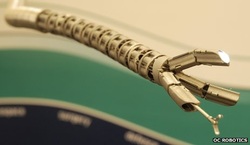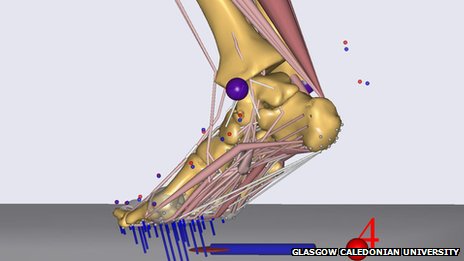Ultra-thin electronics that dissolve inside the body have been devised by scientists in the US and could be used for a range of medical roles. The devices can "melt away" once their job is done, according to research published in the journal Science. The technology has already been used to heat a wound to keep it free from infection by bacteria. The components are made of silicon and magnesium oxide, and placed in a protective layer of silk. It is part of a field termed "transient electronics" and comes from researchers who have already developed "electronic tattoos" - sensors that bend and stretch with the skin.
They described their vanishing devices as the "polar opposite" of traditional electronics, which are built to be stable and to last. "Transient electronics offer robust performance comparable to current devices but they will fully re-absorb into their environment at a prescribed time, ranging from minutes to years. A range of uses have already been tested in the laboratory. One likely use would be in wounds after surgery. Infection is a leading cause of readmission, a device could be put in to the body at the site of surgery just before it is closed up. But you would only need it for the most critical period around two weeks after surgery. There are also ideas around using the technology to slowly release drugs inside the body or to build sensors for the brain and heart.
http://www.bbc.co.uk/news/health-19737125

One of the challenges with cutting away a tumour is making sure that all of it is removed. For this, the surgeon needs to understand where the tumour stops, which can be tricky. At theUniversity of Bernin Switzerland, scientists inject a drug into the patient's body and once attached to the tumour, it starts glowing when light is shone on it. This imaging technology is also applied to instruments as they navigate inside the body, the same way a GPS helps us find our way home. "It is about tracking surgical instruments, so that a surgeon sees on a computer screen as a medical tool moves through the body, overlaying it with CT scan data - just like an augmented reality application "If you look at the liver, for example, it's a homogeneous, reddish-brownish organ, but you would like to see where the tumours are. By making tumours glow, it is easier for surgeons to spot them on a screen using
augmented reality technology. We scan the patient, derive a 3D model of the liver with the vessels, and in that model we see the tumours so we can tell the surgeon where to cut. Detection of vessels, aligning the model with the patient's anatomy, and doing it precisely - even five years ago computers weren't able to do this.
http://www.bbc.co.uk/news/health-19653105
Death rates from cancer are "set to fall dramatically" by 2030, according to Cancer Research UK. It says fewer people smoking as well as improvements in diagnosis and treatment will lead to a 17% drop in death rate. About 170 UK deaths per 100,000 of population were from cancer in 2010, and this figure is predicted to fall to 142 out of every 100,000. Some of the biggest killers - lung, breast, bowel, and prostate cancer - are part of the trend. The biggest fall is projected to be in ovarian cancer, with death rates dropping by 43%. Prof Peter Sasieni, from Queen Mary, University of London, said: "Our latest estimations show that for many cancers, adjusting for age, death rates are set to fall dramatically in the coming decades."
As more people live to an elderly age, the total number of people who actually develop and die from cancer will increase - but these deaths will make up a smaller proportion of the total number of deaths, so the death rate will fall. However, the death rate for other cancers such as those of the liver and mouth will increase over the next two decades. A spokesperson for Cancer research UK said "Our real problem is not spotting cancer early enough"
The chief executive of Cancer Research UK, Dr Harpal Kumar, said: "These new figures are encouraging and highlight the huge progress we're making. "Research across many areas is having real impact."
The Department of Health said: "These figures reflect improvements in cancer services, but we know there is still more to do. "Our aim is to save 5,000 more lives every year by 2015 - and halve the gap in cancer survival between us and the best-performing countries in Europe."
http://www.bbc.co.uk/news/health-19703834
Drug-free treatment for migraine which, it is claimed, alleviates pain in sufferers plagued by the chronic condition was described by doctors yesterday as an "exciting innovation". The hand-held device, which delivers a brief magnetic pulse to the back of the head, reduced the frequency of headaches in more than half of patients prescribed it in a clinical trial. The findings were presented at the European Headache and Migraine Trust International Congress in London yesterday. Migraine affects an estimated eight million people in Britain. It is caused by an "oversensitive" brain which reacts to triggers such as fatigue, hunger, stress or the weather with a throbbing, headache, often accompanied by nausea and visual disturbances. Specialists at migraine clinics in London, Bath, Hull, Exeter, Liverpool and Aberdeen prescribed the device to patients, of whom almost three-quarters (73 per cent) reported a reduction in pain. Almost two-thirds said associated symptoms such as nausea were improved. No figures for the number of patients involved in the trial, the source of funding or the cost of the device were available. The Spring Transcranial Magnetic Stimulation device was developed by eNeura Therapeutics in the United States. Anna Andreou, headache research fellow in the anaesthetics, pain medicine and intensive care section at London's Imperial College, who tested the device, said it decreased activity along nerve pathways. "It is a safe, non-invasive technology," she said. Professor Peter Goadsby, the congress joint chair and a neurologist, said: "For the many migraine sufferers whose medicines just do not do the job, it is exciting to see such an innovative, novel approach to treatment." One patient who took part in the trials said: "I have suffered migraine for nine years, tried a lot of medicines and saw different consultants to no avail. I could be completely debilitated for a whole week, needed time off work and was at my wit's end. Now the device helps me to cope." Dr Fayyaz Ahmed, a Hull-based neurologist who chairs the British Association for the Study of Headache, said: "We think neurostimulation is the future in treating headache disorders. A significant proportion of migraine sufferers either do not respond to or are unable to tolerate available oral treatments” http://www.independent.co.uk/life-style/health-and-families/health-news/doctors-are-excited-by-drugfree-migraine-therapy-8163882.html
Research from the US has given scientists a better understanding of the genetic and molecular defects inside breast cancer cells. International researchers working as part of the Cancer Genome Atlas (TCGA) project have completed the genetic mapping of 800 breast tumours, giving researchers a clearer view into the defects behind each sub-type of breast cancer, as well as providing pointers towards new treatments. The study, published in Nature, also identified a molecular similarity between one sub-type of breast cancer - known as 'Basal-like' - and a hard-to-treat form of ovarian cancer. The researchers looked at the 800 tumours in vast detail, examining their genetic defects, and other aspects of their biology, such as the degree to which different genes and pathways were switched on, and whether their DNA was chemically modified. They compared these analyses to four previously known sub-types of breast cancer: HER2-enriched, Luminal A, Luminal B and Basal-like.
"This comprehensive new analysis of 800 breast tumours is a welcome addition to the wealth of new information about the underlying biology of breast cancer, and will be a precious and valuable resource for cancer researchers," said a breast cancer expert for Cancer Research UK. "This will allow us to further refine understanding of the disease, with the ultimate aim of improving things for those who matter most - people diagnosed with breast cancer." The study corroborated the findings of the Cancer Research UK-funded METABRIC study, which revealed breast cancer to be ten separate diseases.
One of the paper's authors, said the study represented "a near complete framework for the genetic causes of breast cancer, which will significantly impact clinical medicine in the coming years." The mapping project gave scientists a better picture of the genetic causes behind the most common form of breast cancer, known as Estrogen-Receptor positive/Luminal A disease. The researchers found that this sub-type had the widest range of genetic alterations, some of which could be targeted by drugs currently in clinical development. The striking similarity between basal-like breast tumours, which are often hard-to-treat 'triple-negative' breast cancers, and ovarian tumours suggests a common origin and the future possibility of treatments that would be effective for both diseases, the researchers said.
"The molecular similarity of one of the principal subtypes of breast cancer to that found in ovarian cancer gives us additional leverage to compare treatments and outcomes across these two cancers," said Professor Harold Varmus, director of the US's National Cancer Institute, which funded the study. "This treasure trove of genetic information will need to be examined in great detail to identify how we can use it functionally and clinically."
http://www.cancerresearchuk.org/cancer-info/news/archive/cancernews/2012-09-21-Study-gives-better-picture-of-genetic-causes-of-breast-cancer?rss=true
 A 30cm (1ft) snake slowly moves through the body of a man on a spotless table, advancing its way around the liver. It stops, sniffs to the left, then turns to the right and slithers behind the ribcage. This is a medical robot, guided by a skilled surgeon and designed to get to places doctors are unable to reach without opening a patient up. It is still only a prototype and has not yet been used on real patients - only in the lab. But its designers, from OC Robotics in Bristol, are convinced that once ready and approved, it could help find and remove tumours. The mechanical snake is one of several groundbreaking cancer technologies showcased at this week's International Conference on Oncological Engineering at the University of Leeds.
Most of the devices are in very early trial stages, but Cancer Research UK says that innovation and research are extremely important in tackling the disease. Surgery is a cornerstone treatment for cancer so new technologies making it even more precise and effective are crucial. Thanks to research, innovations such as keyhole surgery and robotics are transforming the treatment landscape for cancer patients and this trend needs to continue. Snake robots could be as minimally invasive as possible with today's technology - they would use body orifices or local incisions as points of entry. They would allow a surgeon to look and "feel" inside the body - by using cameras and extremely sensitive equipment to provide feedback. "It can be a lot cheaper for a hospital because you can use it all day long for different applications."
http://www.bbc.co.uk/news/health-19653105
An advanced virtual model of the human foot has been created by researches to drive forward improvements in treating serious injuries and illness. The 3D model depicts bones, joints, ligaments, muscles and tendons in an unprecedented level of detail. It will be used to develop advanced treatments for conditions ranging from foot and ankle problems to amputations. The 3.7 million euro a-footprint project is being led by Glasgow Caledonian University (GCU). The human foot is particularly difficult to model because of its complexity. Researchers worked in partnership with the Maastricht University and Danish biomechanical firm AnyBody Technology on what had been named the Glasgow/Maastricht Foot Model. It is estimated that 200 million Europeans suffer from disabling foot and ankle conditions and the model should lead to more efficient orthotic devices, cutting recovery times and reducing symptoms. It will also have applications in treating flat feet or foot drop - which prevents recovering stroke patients from moving their ankles and toes. GCU's Professor Jim Woodburn, who is the project co-ordinator, said: "Previous to this development, most computer models of the human body ended in a black rectangle as the foot was simply too complicated to model.
The Glasgow/Maastricht foot is a game-changer. "It opens the door to a huge range of applications, including the manufacture of better and more efficient orthotics, resulting in quicker recovery times, reduced symptoms and improved functional ability for those suffering from conditions which afflict the foot and lower leg." The simulation can be used to test potential cures as well as developing new orthotic devices, using 3D printing techniques.
http://www.bbc.co.uk/news/uk-scotland-glasgow-west-19660736
It's about making sure you monitor and get care for problems like cardiovascular issues and bone density issues that might happen because of some of your cancer treatments. It's the health prevention piece that's usually done in primary care," said. Dr. Catherine Broome, an associate professor of medicine and a medical oncologist at Georgetown University's Lombardi Comprehensive Cancer Centre, said while the study is small, it does raise important issues. "As a medical community in general, we've struggled with this question about follow-up care for a number of years. Economics and health care reimbursements are beginning to play a role in how we're asked to manage these patients," Broome said. "I personally do like to try and follow my patients much longer than the first few years. When I see them, I may be a bit more focused on some of those things that might be overlooked by a primary care physician, like an early-stage breast cancer patient who got chemo and may be cured but who might experience long-term effects such as thyroid abnormalities," said Broome. "The subtle signs might be more obvious to us."
http://www.cancercompass.com/cancer-news/article/42054.htm?c=NL20120919
Macmillan said people should not have to wait until their next hospital appointment to get answers. Cancer support and information services will be offered in libraries across Glasgow in what is thought to be the first project of its kind in the UK. Macmillan Cancer Support and Glasgow Life are working together to ensure every cancer patient in the city can get help within their local community. Trained volunteers will be available in 25 libraries across the city offering emotional and practical guidance. The charity hopes the scheme will be a model for the rest of Scotland. A Macmillan Service Delivery Manager will lead each team, which can also refer people to other services the charity offers. Macmillan's general manager in Scotland Allan Cowie said: "We are delighted to have made Glasgow the first place in the UKwhere everyone affected by cancer can get information and support in their local community.” When someone is diagnosed with cancer or a loved one is diagnosed, they have lots of questions and concerns." 'No waiting' He added: "They shouldn't have to wait until their next hospital appointment to get answers or have to travel across the city to get support. This project will allow everyone with cancer or their friends and families to access the support and information they need on their doorstep, something we know is very important to people at a very difficult time."
The Macmillan support and information centres are currently open in Pollok, Dennistoun, Easterhouse, Springburn and the city's Mitchell Library, with the rest of the centres to open over the next year. Cancer Support Scotland, another partner in the service, will offer counselling and complementary therapies in some libraries. Tommy Nugent, who was diagnosed with cancer in 2009 and uses the Easterhouse library support service, said: "Finding the Macmillan project in my local library helped me tremendously. "The fact I could walk to it was great, when you are going through cancer you can feel really quite ill and travelling is not something you want to do. "The cost of travelling could also put people off even attempting to access support so I'm glad to see similar services are being put in libraries across the city."
http://www.bbc.co.uk/news/uk-scotland-glasgow-west-19625211
|




 RSS Feed
RSS Feed